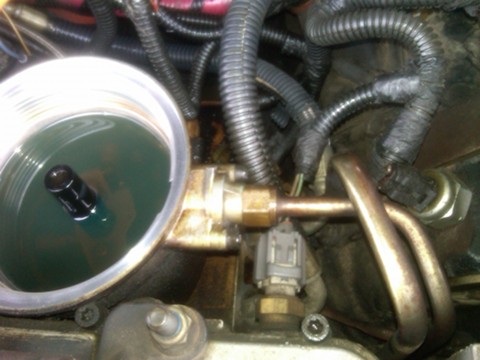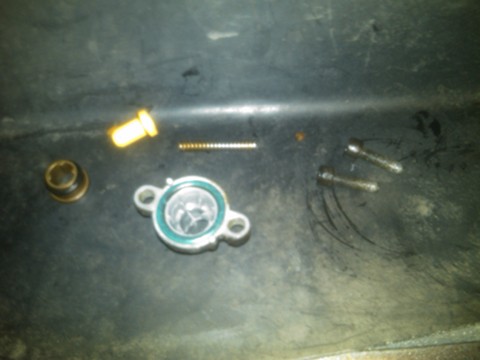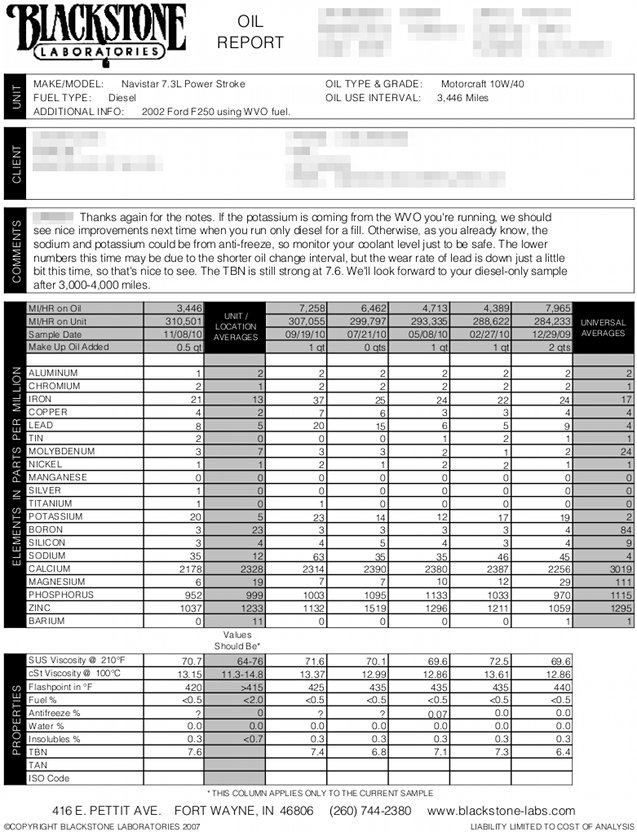My last update briefly mentioned a recent problem with high fuel pressure. I wanted to expand on that since I was *not* able to find a solution online. I started swapping parts with another 7.3L PSD until I pinpointed the problem.
Baseline:
My fuel pressure gauge (0-100 psi) usually shows 60 psi max pressure. The gauge is connected to an isolator via an air tube. The isolator is connected to the rear passenger side of the fuel filter bowl (aka water separator bowl) via a braided steel fuel hose and reads the pressure (on the clean side of the filter) in the fuel filter bowl. The gauge normally reads 60 psi. When running diesel or *hot* WVO, my pressure hardly drops from 60 psi, except during WOT (wide open throttle). Even then, it rarely drops below 35-45 psi. It seems like my pressure never exceeds 62-64 psi, usually higher than 60 psi for only seconds after letting off WOT.
Symptoms:
While on a long-distance trip, my gauge suddenly spiked to 100+ psi (max reading on gauge). I looked things over during the next stop, but didn’t see any obvious problems. Later the same day, I could smell WVO while driving. Pulled over and found that the fuel filter cap had cracked along the lip and was spraying WVO in the engine compartment. Replaced the fuel filter cap and was up and running again.
Summary of Fuel System (2002 F-250 7.3L):
My understanding of the fuel system, based on hours of research and diagram reviews, is as follows. The fuel pump (mounted to frame below driver’s feet) pulls fuel directly from the tank and pressurizes the fuel supply up to the fuel bowl. Sounds like this 12V factory fuel pump can output somewhere between 110-130 psi. There is a housing on the top driver’s side of the fuel filter bowl that contains the pressure relief valve and feeds the return line that sends fuel back to the tank. The housing and it’s contents (sleeve, plunger, springs, seals) are designed to let excess fuel/pressure return to the tank so that pressure in the fuel supply and fuel bowl do not exceed 60 psi.
Diagnosis / Solution:
I disassembled the fuel pressure relief housing (and contents), clean the contents and reassemble everything. My fuel pressure rode between 70-80 psi for a while, but gradually increased to 85-90-95 psi over the course of 20-30 minutes. The fuel pressure eventually returned to 100+ psi (guessing 110-115 psi, based on how much fuel it took to drop the pressure below 100 psi). I would get the exact same results if I disassembled and cleaned everything again.
I thought my return line was clogged. I blew out the return fuel line with an air hose. Exact same results as above. Pressure gradually increased to 100+ psi again.
The return line connects to the housing with some sort of compression fitting. Someone else suggested (here) that they were able to resolve my symptoms by making sure that the return line was pulled out (to the driver’s side) as much as possible when the hex head/fitting was tightened. This did not fix the problem either.
Ran this problem by the head service tech at our local dealership (Terry?). He did some quick research and confirmed that the fuel supply pressure specifications considered 45-80 psi to be the safe range. He suggested I replace the fuel pressure relief kit inside the housing (sleeve, plunger, spring, seals) and agreed that the issue had to be in that general area.
I swapped the pressure relief kit with another 7.3L. No luck. I swapped the small metal housing that holds the pressure relief kit with another 7.3L. While I cannot explain why, this *DID* resolve my high pressure problem! I purchased a brand new housing and installed it. Fuel pressure has been at 60 psi max ever since.
Ford / International Part Numbers:
F81Z-9B249-BB — Ford Regulator Module Kit — $76.35 (list price)
F81Z-9H323-BB — Ford Regulator Valve Closure Cap — $51.62 (list price) — When I opened the Ford bag, the second bag still had an International Truck and Engine Corporation label! This is International P/N 1831444C91.
F81Z-9G270-BA — Ford Fuel Filter Cap — $58.38 (list price)
Summary:
I ended up purchasing/replacing the “F81Z-9H323-BB” housing to solve my high fuel pressure problem in my 2002 7.3L PSD. Had I known this was a repackaged I/H part, I would have gone to International for a less expensive part. FYI, you can purchase an aftermarket cap that’s nearly identical to the Ford Fuel Filter Cap for around $20. The cheaper caps run $12-14. I keep a spare along in case my fuel pressure ever happens to go through the roof again.
Pictures:
The fuel pressure relief valve enclosure is shown in the center of this picture. Mounted to the top driver’s side of the fuel filter bowl with a pair of screws (27 star bit?). The fuel return line is attached to the enclosure with some sort of compression nut.

The innards of the fuel pressure relief valve are shown in the picture below. The sleeve (far left) and it’s seal are pressed into the fuel bowl from the driver’s side. The yellow/copper plunger slides into the sleeve from the driver’s side. The spring slides into the hole in the end of the plunger, also from the driver’s side. Those 3 parts cost $76.35! The spring pushes against the center of the housing. I replaced the housing, green o-ring, and two black screws. Those 4 parts cost $58.38! Does everyone pay list price, or do I need to do a better job of kissing dealership ass?

Glad this is resolved. Disappointed by the high prices of these little tiny parts. Will check with the parts department at International first the next time something like this comes up.


